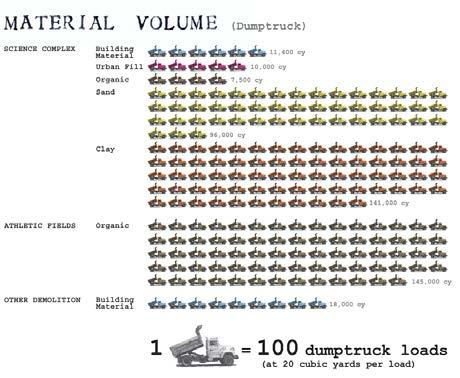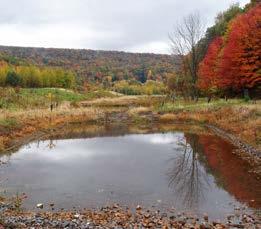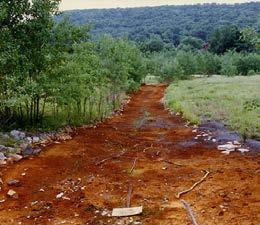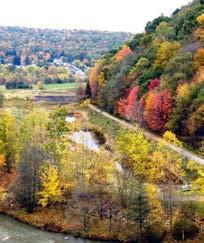
5 minute read
Just a Girl From New Jersey
It is important to first dig into her past to understand her process. Born in New Jersey, Bargmann often talks about her early influences as views from the back seat of her dad’s car. She talks about the meadowlands, a vast network of wetlands surrounded by industrial activity, to be beautiful. She was also highly influenced by her mother’s artistic abilities. Her mother would often encourage her to doodle on homework and reward her with sketchbooks and watercolor sets.
As with many other children, Bargmann loved to play in the dirt, but that sense of play became a passion. She went on to study sculpture at Carnegie-Mellon University, but when she gained her degree, she was frustrated by the static nature of art. She was uninterested in the idea of her work sitting in a gallery for people to peruse. At this time, she was living in Boston and trying to figure out what she wanted to do. She calls this period in her life the “black hole period.” (Bargmann, 2021) It was not until she went back to the writings of Robert Smithson that she discovered landscape had the potential to connect many of her interests - science, art, environment.
Advertisement
From there, she went on to get her master’s at the Harvard Graduate School of Design (GSD). At the time, her peers were not thinking about industrial landscapes. She proclaims, “I found myself on the margins of the discipline, which is a comfortable spot for me as an artist.” (Hamilton & Bargmann, 2016) While at the GSD, she developed a love for teaching as an assistant for design studios and technical courses. Instead of jumping right into educating, though, she worked for Michael Van Valkenburgh Associates for several years. This allowed her to build the groundwork for teaching but also her practice. She opened her studio and research practice, both called D.I.R.T. when she was a professor at the University of Minnesota. The studio focused on regenerative landscapes, filling a niche in the realm of landscape architecture at the time.
D.I.R.T. (Dump It Right There)
There are not two similar projects in Bargmann’s catalog of work. Even in the early days of D.I.R.T., every project was unique because every site was unique. In a time when designers wanted the ability to control and gain recognition for the newest, brightest, most beautiful park or plaza, how did Bargmann keep her cool and fight for what she believed in? A lot of it was similar to her peers - ego, but also her ability to process sites differently than other studios. Instead of wiping the site clean and starting from a blank canvas, she never allowed any material found on the site to leave the site. She claims that sometimes this meant that the client walked away, but she never backed down on this statement. In some cases, it meant keeping her strategies a secret so the client did not call her “the crazy liberal lady” (Bargmann, 2015) but in the end, the site still retained all of its dirt.
Many of the lessons she learned from Van Valkenburgh are easy to trace when listening to him speak about his practice and influences. In a talk at the Isabella Stewart Gardner Museum in 2015, he quotes Robert Smithson and talks about materiality like it is a religion. Bargmann’s keen sense of materiality and the ability to create landscapes that are more than just something to look at come straight from her time with Van Valkenburgh.
The Bargmann L.E.N.S. (Leave Everything, No Sacrifices)
There are three main tactics to explore about Bargmann that have earned her the title “Queen of Slag.” (Graves, 2006) The first is her hyper-focus on the site, the second is her stubbornness not to take anything off the site, and the third is her ability to add elements that catalyze regeneration rather than force it. The following case studies explore what the world looks like through the Bargman lens: site specificity, material magic, and catalyzing regeneration.
Case Study 1: A Toxic Orange Sludge
VINTONDALE RECLAMATION PARK Vintondale, Pennsylvania
1995 – 1998
The Vintondale area had been devastated by acid mine drainage left by shut down coal companies. The toxic discharge created a severe water quality problem and destroyed entire watersheds. A historic preservationist, T. Allan Comp, saw potential in the land to remediate it and build public spaces for the community to enjoy. (Comp, 2016) In order to do this, he choreographed a team of artists, designers, scientists, historians, local communities, watershed groups, and state and federal agencies to bring his vision to life. Among those teams was D.I.R.T.

The project’s first phase focused on a forty-acre floodplain. A key artery in the area, Blacklick Creek, was being slammed with acid mine drainage at a rate of two hundred gallons per minute. (Reese, 2007) Cleansing the area was an essential step to creating a usable space. The strategy to clean the water included installing a series of ponds that would slowly filter the polluted water before it reached the creek. The ponds were lined with limestone that naturally pulled the iron out. As the water trickled down these limestone slabs, it would slowly become cleaner and cleaner until finally returning to the creek purified.

To complement the changing color of the water - from red/ orange to green/blue - trees were planted around the ponds to represent the changing hues. Specific native tree species were chosen to show off their autumn colors; black cherry and sweetgum at the top turn bright red, sugar maple, poplar, and hackberry in the middle, turning yellow and orange, and black willows at the bottom that are light green.

A large part of Bargmann’s work strives to unearth the mystery of site remediation. In this case, using the ponds to clean the water allows people to engage with the experience, and the trees complement that experience. It has led to other installations that honor the process in their own way. One example is a slab of slate at the base of the ponds where the clean water rolls into Blacklick Creek called The Clean Slate. Park visitors are invited to let the clean water wash over their feet as it finishes its journey.
In this case, Bargmann catalyzed the ability of the community to reclaim this space. Cleaning the water, adding a few footpaths alongside the ponds, and installing trees were all that was necessary for this space to thrive.
The Bargmann L.E.N.S.
Site Specific: The most site specific part of this project was Bargmann’s ability to see the beauty in the surrounding environment and create a space for people to enjoy it. In many articles about the project, the community is described as blind to the region’s natural beauty because of the ugly orange tainted ground and water. Bargmann knew that people would see the natural beauty by cleaning that ugliness.
Material Magic: Using gravity to clean the water, no additional mechanisms were added to treat the acid-ridden streams chemically. The dirt removed to build the ponds would have been reused to build up the walls of the ponds and allow for the added footpaths. The only materials brought in were local slate and native trees.
Catalyze Regeneration: The site was not over-designed. Bargmann laid the groundwork (literally) for the ecosystems to thrive, giving room for the community to appropriate the land for their needs. Art installations have been added today, and a bike path connects 46 miles of trails.









